ECO mode Citroen C5 2017 (RD/TD) / 2.G Owner's Guide
[x] Cancel search | Manufacturer: CITROEN, Model Year: 2017, Model line: C5, Model: Citroen C5 2017 (RD/TD) / 2.GPages: 348, PDF Size: 10.72 MB
Page 118 of 348
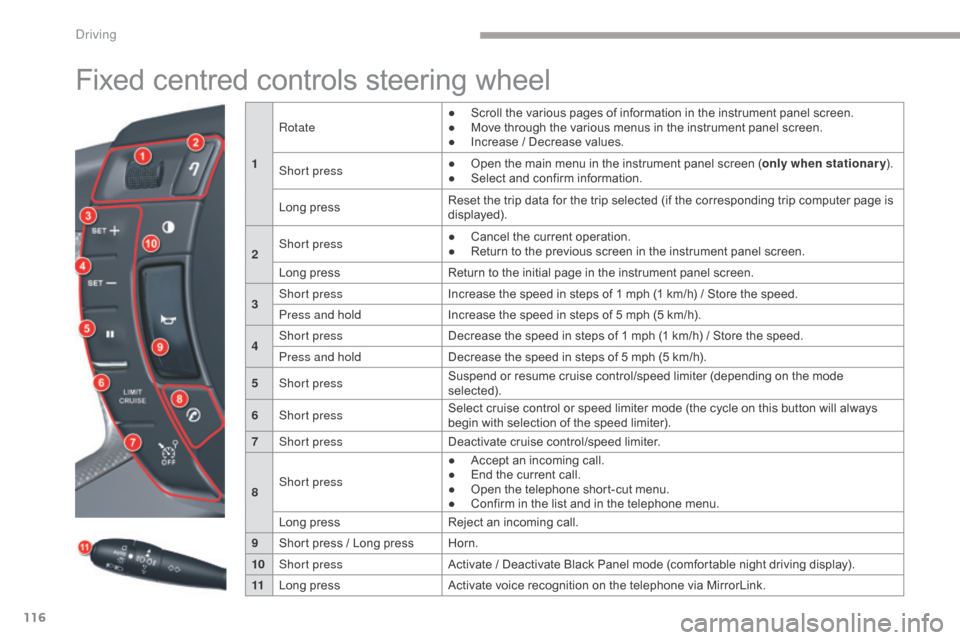
116
C5_en_Chap04_conduite_ed01-2016
Fixed centred controls steering wheel
1Rotate
●
S
croll the various pages of information in the instrument panel screen.
●
M
ove through the various menus in the instrument panel screen.
●
I
ncrease / Decrease values.
Short press ●
O pen the main menu in the instrument panel screen (
only when stationary).
● S elect and confirm information.
Long press Reset the trip data for the trip selected (if the corresponding trip computer page is
displayed).
2 Short press
●
C
ancel the current operation.
●
R
eturn to the previous screen in the instrument panel screen.
Long press Return to the initial page in the instrument panel screen.
3 Short press
Increase the speed in steps of 1 mph (1 km/h) / Store the speed.
Press and hold Increase the speed in steps of 5 mph (5 km/h).
4 Short press
Decrease the speed in steps of 1 mph (1 km/h) / Store the speed.
Press and hold Decrease the speed in steps of 5 mph (5 km/h).
5 Short press Suspend or resume cruise control/speed limiter (depending on the mode
selected).
6 Short press Select cruise control or speed limiter mode (the cycle on this button will always
begin with selection of the speed limiter).
7 Short press Deactivate cruise control/speed limiter.
8 Short press ●
A
ccept an incoming call.
●
E
nd the current call.
●
O
pen the telephone short-cut menu.
●
C
onfirm in the list and in the telephone menu.
Long press Reject an incoming call.
9 Short press / Long press Horn.
10 Short press Activate / Deactivate Black Panel mode (comfortable night driving display).
11 Long press Activate voice recognition on the telephone via MirrorLink.
Driving
Page 119 of 348
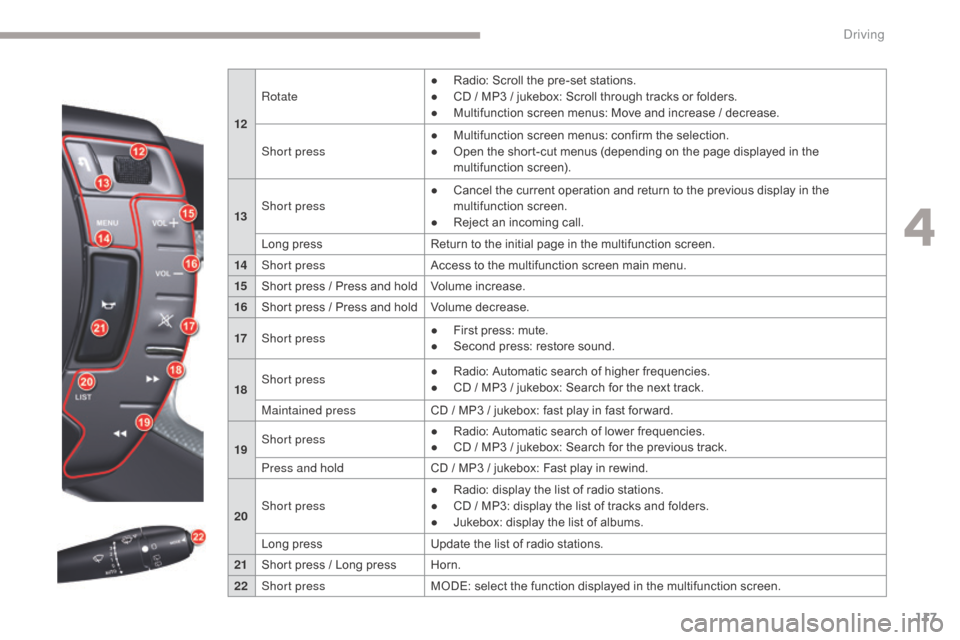
117
C5_en_Chap04_conduite_ed01-2016
12Rotate
●
R
adio: Scroll the pre-set stations.
●
C
D / MP3 / jukebox: Scroll through tracks or folders.
● M ultifunction screen menus: Move and increase / decrease.
Short press ●
M ultifunction screen menus: confirm the selection.
●
O
pen the short-cut menus (depending on the page displayed in the
multifunction screen).
13 Short press ●
C
ancel the current operation and return to the previous display in the
multifunction screen.
●
R
eject an incoming call.
Long press Return to the initial page in the multifunction screen.
14 Short press Access to the multifunction screen main menu.
15 Short press / Press and hold Volume increase.
16 Short press / Press and hold Volume decrease.
17 Short press ●
F
irst press: mute.
●
S
econd press: restore sound.
18 Short press
●
R
adio: Automatic search of higher frequencies.
●
C
D / MP3 / jukebox: Search for the next track.
Maintained press CD / MP3 / jukebox: fast play in fast for ward.
19 Short press
●
R
adio: Automatic search of lower frequencies.
●
C
D / MP3 / jukebox: Search for the previous track.
Press and hold CD / MP3 / jukebox: Fast play in rewind.
20 Short press ●
R
adio: display the list of radio stations.
●
C
D / MP3: display the list of tracks and folders.
●
J
ukebox: display the list of albums.
Long press Update the list of radio stations.
21 Short press / Long press Horn.
22 Short press MODE: select the function displayed in the multifunction screen.
4
Driving
Page 123 of 348
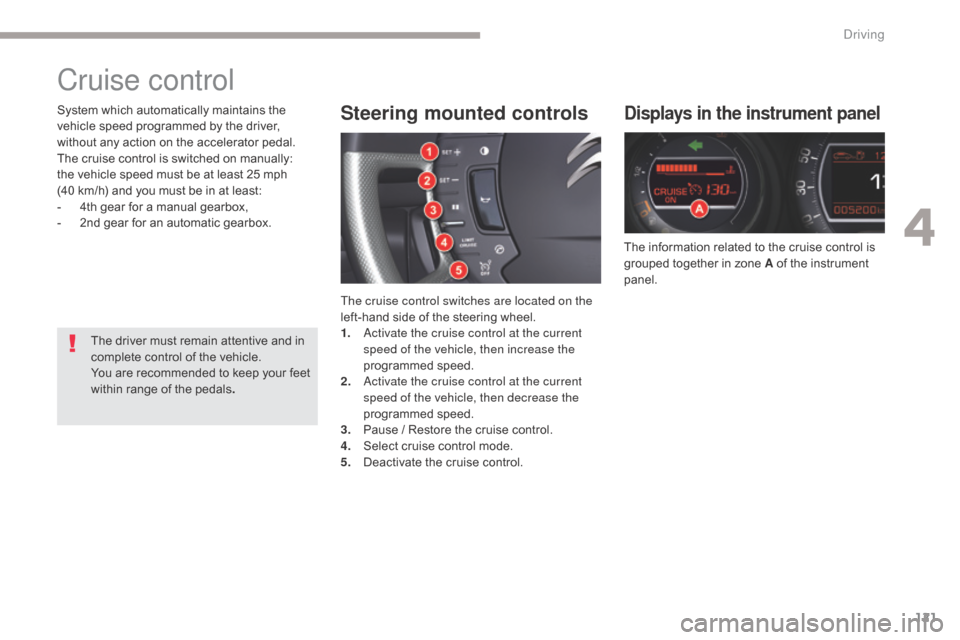
121
C5_en_Chap04_conduite_ed01-2016
Cruise control
Displays in the instrument panel
The information related to the cruise control is
grouped together in zone A of the instrument
panel.
Steering mounted controls
The cruise control switches are located on the
left-hand side of the steering wheel.
1.
A
ctivate the cruise control at the current
speed of the vehicle, then increase the
programmed speed.
2.
A
ctivate the cruise control at the current
speed of the vehicle, then decrease the
programmed speed.
3.
P
ause / Restore the cruise control.
4.
S
elect cruise control mode.
5.
D
eactivate the cruise control.
System which automatically maintains the
vehicle speed programmed by the driver,
without any action on the accelerator pedal.
The cruise control is switched on manually:
the vehicle speed must be at least 25 mph
(40
km/h) and you must be in at least:
-
4
th gear for a manual gearbox,
-
2
nd gear for an automatic gearbox.
The driver must remain attentive and in
complete control of the vehicle.
You are recommended to keep your feet
within range of the pedals .
4
Driving
Page 136 of 348
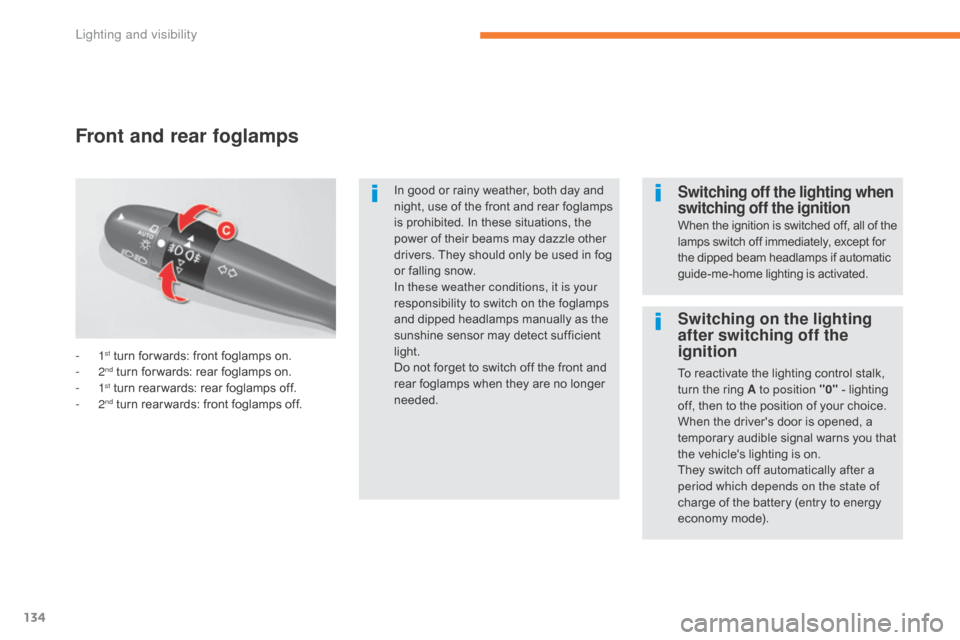
134
C5_en_Chap05_eclairage-et-visibilite_ed01-2016
- 1st turn for wards: front foglamps on.
-
2nd turn for wards: rear foglamps on.
-
1st turn rear wards: rear foglamps off.
-
2nd turn rear wards: front foglamps off.
Front and rear foglamps
In good or rainy weather, both day and
night, use of the front and rear foglamps
is prohibited. In these situations, the
power of their beams may dazzle other
drivers. They should only be used in fog
or falling snow.
In these weather conditions, it is your
responsibility to switch on the foglamps
and dipped headlamps manually as the
sunshine sensor may detect sufficient
light.
Do not forget to switch off the front and
rear foglamps when they are no longer
needed.Switching off the lighting when
switching off the ignition
When the ignition is switched off, all of the
lamps switch off immediately, except for
the dipped beam headlamps if automatic
guide-me-home lighting is activated.
Switching on the lighting
after switching off the
ignition
To reactivate the lighting control stalk,
turn the ring A to position "0" - lighting
off, then to the position of your choice.
When the driver's door is opened, a
temporary audible signal warns you that
the vehicle's lighting is on.
They switch off automatically after a
period which depends on the state of
charge of the battery (entry to energy
economy mode).
Lighting and visibility
Page 181 of 348
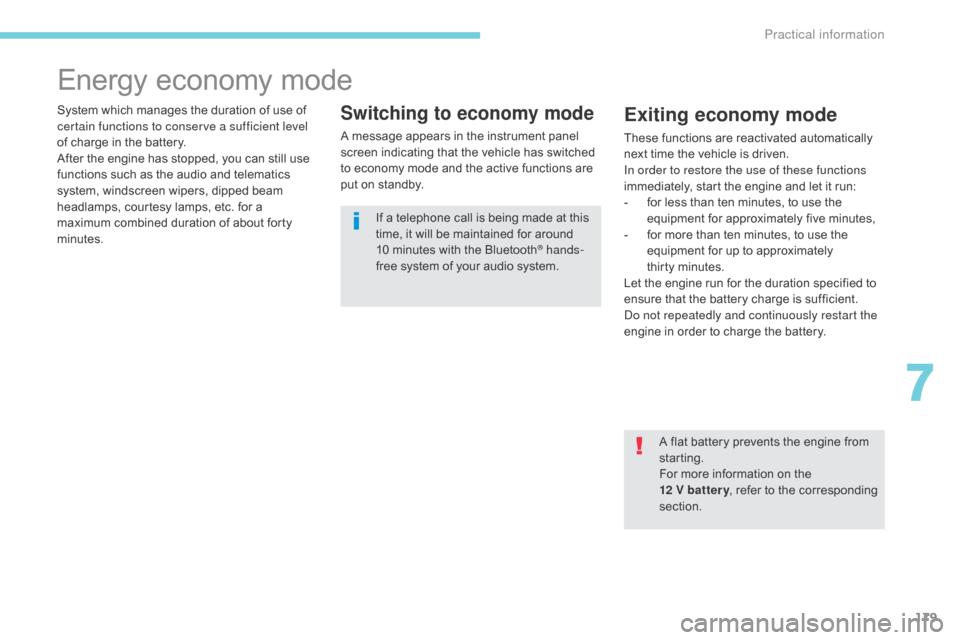
179
C5_en_Chap07_info-pratiques_ed01-2016
Energy economy mode
System which manages the duration of use of
certain functions to conserve a sufficient level
of charge in the battery.
After the engine has stopped, you can still use
functions such as the audio and telematics
system, windscreen wipers, dipped beam
headlamps,
courtesy lamps, etc. for a
maximum combined duration of about forty
minutes.Switching to economy mode
A message appears in the instrument panel
screen indicating that the vehicle has switched
to economy mode and the active functions are
put on standby.
If a telephone call is being made at this
time, it will be maintained for around
10
minutes with the Bluetooth
® hands-
free system of your audio system.
Exiting economy mode
These functions are reactivated automatically
next time the vehicle is driven.
In order to restore the use of these functions
immediately, start the engine and let it run:
-
f
or less than ten minutes, to use the
equipment for approximately five minutes,
-
f
or more than ten minutes, to use the
equipment for up to approximately
thirty
m
inutes.
Let the engine run for the duration specified to
ensure that the battery charge is sufficient.
Do not repeatedly and continuously restart the
engine in order to charge the battery.
A flat battery prevents the engine from
starting.
For more information on the
12
V batter y, refer to the corresponding
section.
7
Practical information
Page 187 of 348
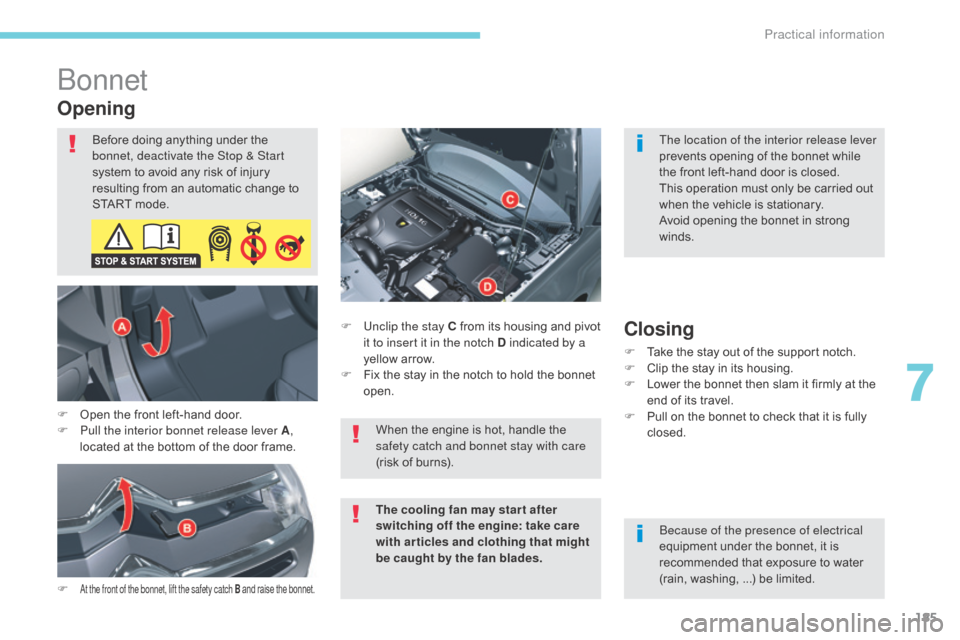
185
C5_en_Chap07_info-pratiques_ed01-2016
Bonnet
Opening
F At the front of the bonnet, lift the safety catch B and raise the bonnet.
F Unclip the stay C from its housing and pivot
it to insert it in the notch D indicated by a
yellow arrow.
F
F
ix the stay in the notch to hold the bonnet
open.Closing
F Take the stay out of the support notch.
F C lip the stay in its housing.
F
L
ower the bonnet then slam it firmly at the
end of its travel.
F
P
ull on the bonnet to check that it is fully
closed.
F
O
pen the front left-hand door.
F
P
ull the interior bonnet release lever A ,
located at the bottom of the door frame. Before doing anything under the
bonnet, deactivate the Stop & Start
system to avoid any risk of injury
resulting from an automatic change to
START mode.
The location of the interior release lever
prevents opening of the bonnet while
the front left-hand door is closed.
This operation must only be carried out
when the vehicle is stationary.
Avoid opening the bonnet in strong
winds.
When the engine is hot, handle the
safety catch and bonnet stay with care
(risk of burns). Because of the presence of electrical
equipment under the bonnet, it is
recommended that exposure to water
(rain, washing,
...) be limited.
The cooling fan may star t after
switching off the engine: take care
with articles and clothing that might
be caught by the fan blades.
7
Practical information
Page 244 of 348
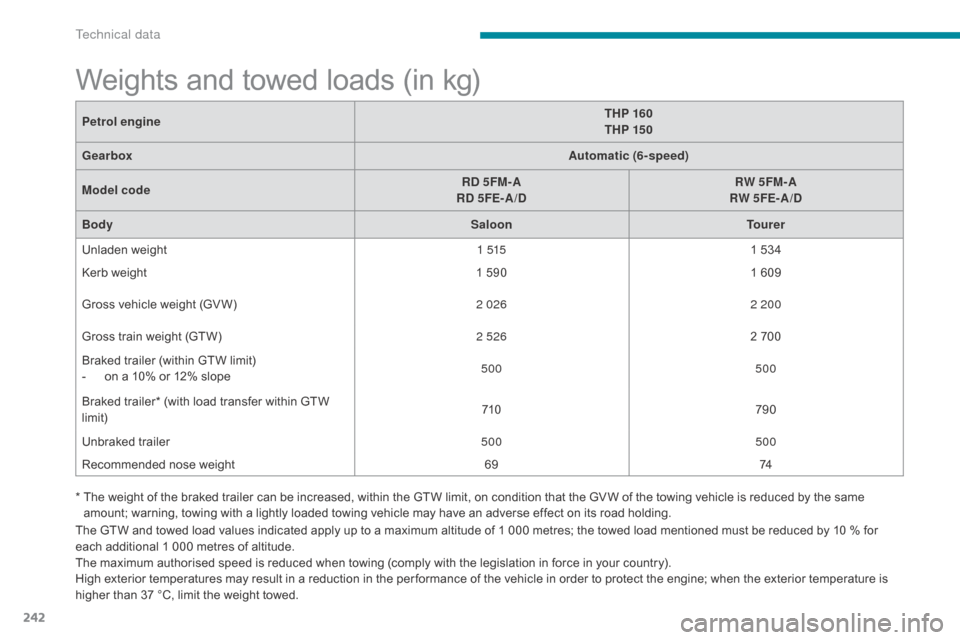
242
C5_en_Chap09_caracteristiques-techniques_ed01-2016
Weights and towed loads (in kg)
Petrol engineTHP 160
THP 15 0
Gearbox Automatic (6-speed)
Model code RD 5FM-A
RD 5FE-A /D RW 5FM-A
RW 5FE-A/D
Body SaloonTourer
Unladen weight 1 5151 534
Kerb weight 1 5901 609
Gross vehicle weight (GV W) 2 0262 200
Gross train weight (GTW) 2 5262 700
Braked trailer (within GTW limit)
-
o
n a 10% or 12% slope 500
500
Braked trailer* (with load transfer within GTW
limit) 710
790
Unbraked trailer 500500
Recommended nose weight 6974
The GTW and towed load values indicated apply up to a maximum altitude of 1 000 metres; the towed load mentioned must be reduced by 10 % for
each additional 1 000 metres of altitude.
The maximum authorised speed is reduced when towing (comply with the legislation in force in your country).
High exterior temperatures may result in a reduction in the per formance of the vehicle in order to protect the engine; when the exterior temperature is
higher than 37 °C, limit the weight towed. *
T
he weight of the braked trailer can be increased, within the GTW limit, on condition that the GV W of the towing vehicle is reduced by the same
amount; warning, towing with a lightly loaded towing vehicle may have an adverse effect on its road holding.
Technical data
Page 246 of 348
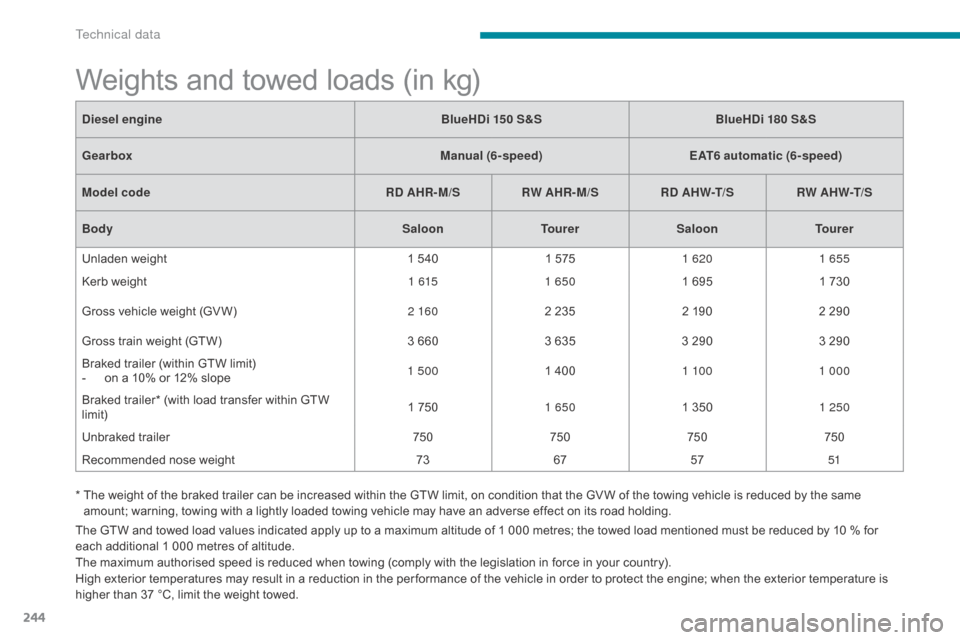
244
C5_en_Chap09_caracteristiques-techniques_ed01-2016
Diesel engineBlueHDi 15 0 S&S BlueHDi 180 S&S
Gearbox Manual (6-speed)EAT6 automatic (6-speed)
Model code RD AHR- M/SRW AHR- M/S RD AHW-T/SRW AHW-T/S
Body SaloonTourerSaloon Tourer
Unladen weight 1 5401 5751 620 1 655
Kerb weight 1 6151 650 1 695 1 730
Gross vehicle weight (GV W) 2 1602 235 2 1902 290
Gross train weight (GTW) 3 6603 6353 290 3 290
Braked trailer (within GTW limit)
-
o
n a 10% or 12% slope 1 500
1 400 1 10 01 000
Braked trailer* (with load transfer within GTW
limit) 1 750
1 650 1 350 1 250
Unbraked trailer 750750750750
Recommended nose weight 736757 51
The GTW and towed load values indicated apply up to a maximum altitude of 1 000 metres; the towed load mentioned must be reduced by 10 % for
each additional 1 000 metres of altitude.
The maximum authorised speed is reduced when towing (comply with the legislation in force in your country).
High exterior temperatures may result in a reduction in the per formance of the vehicle in order to protect the engine; when the exterior temperature is
higher than 37 °C, limit the weight towed. *
T
he weight of the braked trailer can be increased within the GTW limit, on condition that the GV W of the towing vehicle is reduced by the same
amount; warning, towing with a lightly loaded towing vehicle may have an adverse effect on its road holding.
Weights and towed loads (in kg)
Technical data
Page 255 of 348
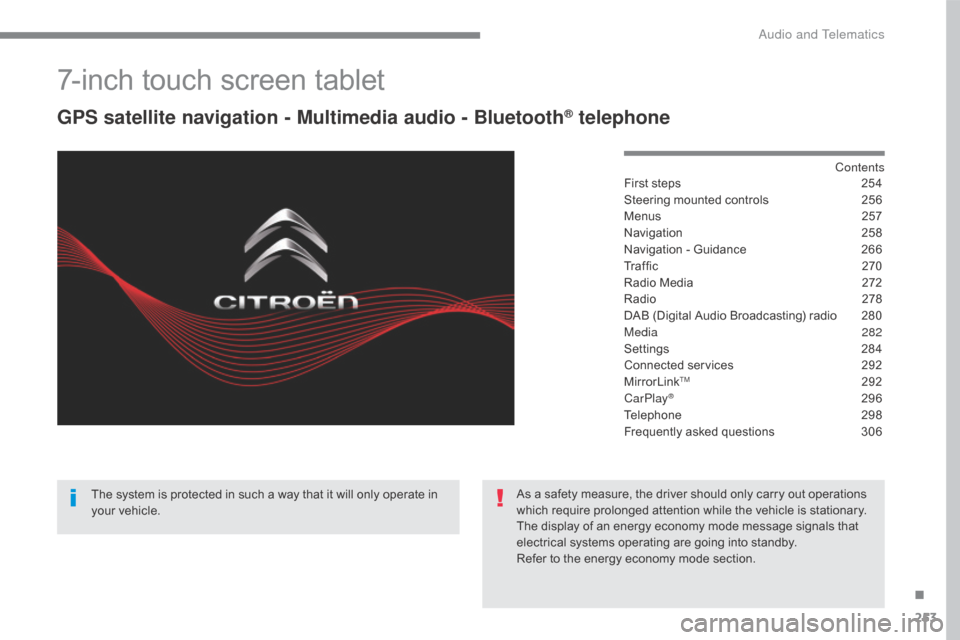
253
C5_en_Chap10b_SMEGplus_ed01-2016
7-inch touch screen tablet
GPS satellite navigation - Multimedia audio - Bluetooth® telephone
Contents
First steps
2 54
Steering mounted controls
2
56
Menus
2
57
Navigation
2
58
Navigation - Guidance
2
66
Tr a f fi c
2
7 0
Radio Media
2
72
Radio
2
78
DAB (Digital Audio Broadcasting) radio
2
80
Media
282
Settings
2
84
Connected services
2
92
MirrorLink
TM 292
CarPlay® 296
Telephone
2
98
Frequently asked questions
3
06
The system is protected in such a way that it will only operate in
your vehicle. As a safety measure, the driver should only carry out operations
which require prolonged attention while the vehicle is stationary.
The display of an energy economy mode message signals that
electrical systems operating are going into standby.
Refer to the energy economy mode section.
.
Audio and Telematics
Page 258 of 348
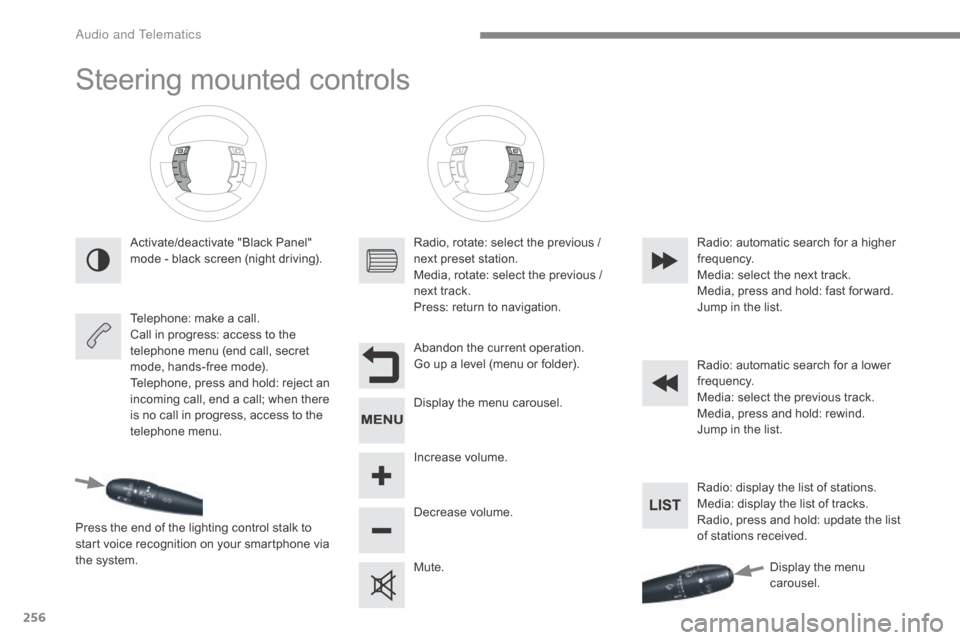
256
C5_en_Chap10b_SMEGplus_ed01-2016
Steering mounted controls
Activate/deactivate "Black Panel"
mode - black screen (night driving).
Telephone: make a call.
Call in progress: access to the
telephone menu (end call, secret
mode, hands-free mode).
Telephone, press and hold: reject an
incoming call, end a call; when there
is no call in progress, access to the
telephone menu.
Press the end of the lighting control stalk to
start voice recognition on your smartphone via
the system. Radio, rotate: select the previous /
next preset station.
Media, rotate: select the previous /
next track.
Press: return to navigation.
Abandon the current operation.
Go up a level (menu or folder).
Display the menu carousel.
Increase volume.
Decrease volume.
Mute.Radio: automatic search for a higher
frequency.
Media: select the next track.
Media, press and hold: fast for ward.
Jump in the list.
Radio: automatic search for a lower
frequency.
Media: select the previous track.
Media, press and hold: rewind.
Jump in the list.
Radio: display the list of stations.
Media: display the list of tracks.
Radio, press and hold: update the list
of stations received.
Display the menu
carousel.
Audio and Telematics